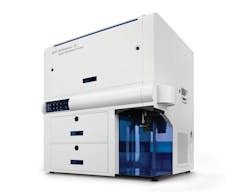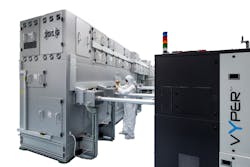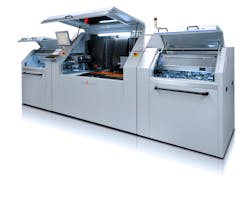
PAUL GINOUVES, DAVE CLARK, MARK GITIN, and RAINER PÄTZEL
In 2015, Laser Focus World contributing editor Jeff Hecht commemorated the magazine's 50th anniversary with a series of articles chronicling major technology milestones. Among the trends, it's interesting to note that some laser technologies, such as ruby, nitrogen, and helium cadmium (HeCd), may have generated initial excitement, but at best penetrated only a few niche markets. Rather, the bulk of today's multibillion-dollar laser market consists of just a handful of "killer applications" that have broken through to significant commercial success.
This year is Coherent's 50th anniversary and, in many ways, the company's history and success mirror such trends in the laser industry. While we continue to offer a broad spectrum of laser technologies that service markets ranging from a few units to tens of thousands of units, long-term success has been driven by a few important applications. This article examines some of the larger commercial market successes for lasers during the past 50 years, viewed through the prism of Coherent's involvement.
Flow cytometry
Many useful diagnostic blood tests performed today utilize flow cytometry for counting specific cell types. Typically, a blood sample is mixed with one or more antibodies, each of which is conjugated to a different fluorescent dye. Thus, for every antibody in solution, there exists a distinct emission wavelength defining the presence of that antibody. Prepared cells are hydrodynamically focused and pass (flow) through one or more tightly focused laser beams. Analyzing the resultant cell-associated fluorescence enables counting of each of the target cell types in the sample.
The first fluorescence flow cytometer was demonstrated by Wolfgang Gohde in Germany in 1968. This lamp-based technology was quickly followed by laser-based technology from such luminaries as Kamentsky, Herzenberg, Fulwyler, and others in the 1970s. Notable additional cell sorting capabilities extended the usefulness of the technology, and commercial interests such as Biophysics Systems (later Ortho Instruments), Becton Dickinson, and Coulter ignited a virtual "arms race" of multi-parameter instruments through the 1980s.
State-of-the-art devices of the period used water-cooled argon or krypton ion lasers because these were the only lasers available that delivered the requisite combination of high power at visible or ultraviolet (UV) wavelengths, together with the excellent beam quality needed for achieving small (cell sized) focused spots. Flurochrome discovery and deployment largely fell in line with discrete emissions from the available lasers, with 488 nm excitable dyes a central focus. Fluorescein isothiocyanate (FITC) and phycoerythrin (PE) attained ubiquity in nearly every flow cytometry lab as a result.
As a pioneer in argon ion lasers since 1969, flow cytometry became one of Coherent's first major commercial successes. Laser technology in general was beginning to move from a technology in search of an application to actually driving significant innovation within an application. Our Innova-series water-cooled ion lasers thus came to dominate flow cytometry in the 1980s. Over time, however, the ongoing evolution of highly reliable and compact air-cooled argon lasers enabled construction of smaller (though still massive compared with today's offerings) and less-expensive cytometers. These cytometers had some drawbacks with respect to multi-parameter, cutting-edge applications, but they acquired significant market share and essentially re-wrote the marketplace dynamics in a relatively short time-span.
It became clear that the clinical flow cytometry market could be greatly expanded with a lower cost, smaller, and more electrically efficient light source than and air-cooled or water-cooled argon laser. When diode-pumped, solid-state (DPSS) lasers were first introduced, these looked like a potential alternative. However, most of the commercially available reagents for cytometry required excitation at 488 nm, and the DPSS frequency-doubled output of 532 nm was only marginally useful.
Coherent's desire to stay ahead of what seemed an inevitable transition led to a concerted quest for alternative technology. Our acquisition of optically pumped semiconductor laser (OPSL) intellectual property proved to be a turning point in this effort. As is typical in the case of core technology acquisitions, we spent several years developing and refining OPSL technology into a real product. In 2001, we introduced the Sapphire, an OPSL that delivered 20 mW output at 488 nm in a TEM00 beam. This laser was 90% smaller than the comparable argon ion laser, consumed 98% less power, and demonstrated substantially better lifetime and reliability, making it an ideal source for flow cytometry.
Yet, the market initially resisted it. Why? For one reason, the purchase price of the first Sapphire was nearly four times that of the air-cooled argon laser. In an ironic additional twist, Sapphire's form factor meant that its incorporation required engineering—the beam position and mounting scheme was entirely new—so it simply was not a "drop-in" replacement. In retrospect, had we packaged it to emulate the ion laser in every way, it might have sped adoption. Not that there wasn't real interest and excitement on many fronts, but it was going to take a new generation of instruments, designed specifically for Sapphire, for it to succeed. One thing is clear: this was a textbook case of genuinely disruptive technology colliding with paradigm-shift latency.
Sapphire's first successes ended up being with some of the smaller, lesser known players in the cytometry market. They viewed it as an opportunity to develop products that were clearly differentiated from those of more well-established companies. This back-door effort on their part served to catalyze end-user demand and accelerated R&D efforts from the big players.
At the same time, Coherent continued to shrink the size of Sapphire, and owing to the flexibility of the OPSL technology, wavelength offerings expanded rapidly. Contemporaneous with the development of new fluorochromes, these advances enabled extraordinarily compact multi-laser cytometers, significantly increasing the number of available fluorescence parameters. These cytometers quickly outpaced the capabilities of the previous generation. Today, such instruments are commonplace, and OPSLs represent a substantial segment of this market (see Fig. 1).
LTPS display annealing
Lambda Physik was one of the pioneers of excimer laser technology, and dominated early applications. The first significant one of these was eye surgery (LASIK), which continues to be the highest unit-volume application for excimers. Another important excimer industrial application, which emerged in the early 1990s, was microlithography. We weren't as successful in this area because the specific technical requirements for microlithography, such as narrow linewidth, were not a perfect fit for the core design of our lasers at that time.
After Lambda Physik was wholly acquired by Coherent in 2003, we started searching for other industrial applications that were better matched to the unique high pulse energies of our excimer products. We were already aware of research showing that lasers could be used to anneal amorphous silicon to create polycrystalline silicon, which is the ideal base for low-temperature-poly-silicon (LTPS) TFTs. This, in turn, enables LCD displays with superior brightness, higher resolution, lower power consumption, and wider viewing angles. As the market for smartphones heated up, LTPS found its killer application, and display manufacturers were keenly interested in any technology that could deliver these kinds of benefits.
The ideal laser for LTPS annealing produces high energy and UV pulses, and has an output beam conducive for shaping into a long, thin line. But this technology congruence for our particular excimer lasers was just the starting point. In fact, it took over a decade for Coherent to develop the market for excimer laser-based display annealing, including close partnerships with key developers of the process, and extensive dialogue with display manufacturers.
In addition to optimizing the laser, we also had to develop the delivery optics to produce the required line beam shape. Moreover, the details of the beam profile (e.g., linearity, uniformity) have a major impact on process throughput and, hence, cost. To this end, Coherent developed strategic partnerships with beam delivery experts, and also brought some of this capability in house through acquisition, such as our purchase of Tinsley Laboratories in 2015, a leader in the manufacture of precision aspheric optics.
Currently, display annealing is Coherent's single largest submarket. However, we can't rest on our past success because this market is highly dynamic. Display manufacturers are continually working to increase their own product quality and functionality, while also reducing costs. A big part of their efforts has been to increase the size of the glass panels from which individual displays are singulated. This, in turn, requires excimer laser annealing systems with longer, higher power line beams.
Thus, you can clearly match the display technology roadmap of the last decade with laser system developments. For example, our first line beam systems produced 200 W of laser power in a 200-mm-long beam, suitable for early products with a few displays per panel. Our newest systems combine the output of three separate lasers into a single, 1.5-m-long beam containing 3.6 kW of power. They are used to process larger panels that yield numerous displays. Needless to say, we follow this field very closely to ensure that our newest excimers are matched with the production technology for the next generation of displays (see Fig. 2).Via drilling
As microelectronics have shrunk in size, many fabrication processes have increasingly transitioned away from mechanical tools. Early on, several manufacturers in the laser industry identified via drilling as a process that would eventually have to move from mechanical to laser drilling. Vias are the small holes in circuit boards used to make electrical connections between layers in integrated circuit (IC) substrates and printed circuit boards (PCBs).
From the outset, laser drilling offered a particularly attractive alternative for the production of blind vias (that don't go through all layers in the circuit board) since these are difficult to produce using mechanical drills. In particular, the CO2 laser rapidly emerged as an ideal source for this application because it can produce blind vias using a simple, three-pulse process. The first pulse drills through the overlying copper, which has a black oxide coating on it to make it absorb infrared (IR). The second pulse drills through the glass resin board substrate material, which absorbs IR. The final pulse cleans out the hole all the way to the underlying copper, which—being uncoated—reflects the beam and self-terminates the hole. This method enables rapid production of accurately sized holes with little post-processing required.
So, CO2 became the main laser technology for blind via drilling. Coherent enjoyed substantial success in this area because our sealed, slab discharge lasers provide the ideal combination of fast rise time and high beam quality essential to via drilling.
Despite this success, we thought that the relentless consumer demand for ever-smaller microelectronic devices would push via sizes below the limit of CO2 lasers, which can deliver diameters down to about 70 μm. In particular, we believed that shorter wavelengths would be necessary to achieve smaller via sizes.
In the mid-1990s, Coherent felt we had more expertise in UV lasers than most of our competitors, including frequency-multiplying crystal materials, UV coatings, and optical mounting technology, and believed this expertise would allow us to develop a better product. We had identified several applications, including via drilling, flex circuits, marking, and small feature-scale material structuring as potential applications. Consequently, we invested considerable resources into developing the AVIA. This was a UV (355 nm) DPSS laser that offered the combination of output power, reliability, and lifetime necessary for high-throughput commercial applications.
But, even today, large-scale adoption of UV lasers for via drilling still hasn't happened for the production of mainstream, high-density interconnect (HDI) circuit boards and IC substrates. Rather, it is largely confined to niche applications like drilling flex PCBs. One reason for this is that via diameters haven't shrunk as quickly as we expected. Also, the UV process is slower and not quite as elegant as the highly efficient, three-pulse CO2 process.
However, over the past few years, a hybrid drilling process for HDI boards and IC substrates has been developed. This uses a UV laser to first drill a small hole directly into copper (without the need to coat it black). This hole then acts as a mask, enabling a CO2 laser to drill the remainder of the via with just two more pulses. This delivers small via diameters (35–50 μm) at market-enabling speeds. We expect its use to expand rapidly over the next few years.
In the meantime, the other applications we had targeted for high-power UV (and green) DPSS lasers grew, and new ones appeared as well. These include various other processes in smartphone manufacturing, scribing low-k semiconductor wafers, and several processes in solar cell fabrication. These applications, together with technical advances that have minimized the size, reduced the cost, and improved the reliability of AVIA lasers, have combined to make it a successful product line (see Fig. 3).In summary, it is tempting to think that if a company develops a product that satisfies a perceived market need, then they will automatically be successful. Yet, real-world markets are often not so predictable. Our success has resulted from a combination of technical breadth and the agility to respond to market trends that we predicted—as well as those that were unanticipated.
ACKNOWLEDGEMENT
BD FACSymphony is a trademark of Becton Dickinson.
Paul Ginouves is director of marketing communications, Dave Clark is director of product marketing – DPSS lasers, Mark Gitin is vice president of diode and fiber laser systems, and Rainer Pätzel is director of strategic marketing, all at Coherent, Santa Clara, CA; e-mail: [email protected]; www.coherent.com.

